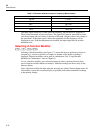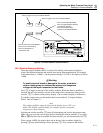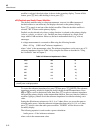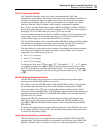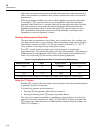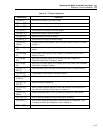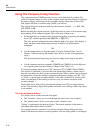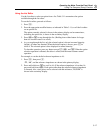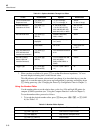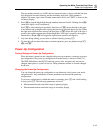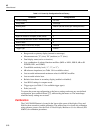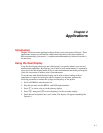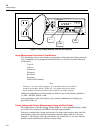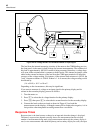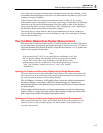
45
Users Manual
3-18
Table 3-11. Options Available Through List Editor
To Set Pushbuttons Options Annunciator
Touch Hold Minimum
Response Level
S then H
(THRESH)
"1" (5 % of range);
"2" (7 % of range); or
"HOLD"
"3" (8% of range)
Decibel Reference
Impedance in Ohms
S then I
(REF e)
2, 4,8,16,50,75,93,
110,124,125,135,150,
250, 300,500,600, 800,
900,1000,1200, or 8000
"dB" and “e“;
also "V" when
1000Ω
RS-232 Baud Rate S then R
(BAUD)
300,600,1200,2400,
4800, or 9600
"baud"
Parity options list
displayed
"E" (even), "O" (odd),
"no" (none)
"PAR" for parity
Echo Mode On or Off "Echo" and "On"
or "OFF"
IEEE-488 Address(If
IEEE-488 Interface
Installed and selected.)
S then J
(ADDR)
Valid addresses between
0-30
"IEEE"
RS-232 PrintOnly
Mode (If RS-232
Interface Selected)
S then T
(ADDR)
1,2,5,10,20,50,100, 200,
500,1000,2000,
5000,10000,20000, or
50000
"PRINT"
Trigger Type E and T
simultaneously
1,2,3,4, 5 (See Table 5-
14.)
"tri"
3. When you have scrolled to 16, press E to set the dB reference impedance. "16" now
becomes bright, indicating that it is the selected value.
This dB reference will remain selected until you change it (as described above), turn the
meter off, or reset the meter to the power-up configuration by pressing and holding down
E during power-up. (See "Changing the Power-Up Configuration" later in Chapter 3.)
Using the Number Editor
Use the number editor to set the relative base, or the low (LO) and high (HI) points for
compare (COMP) operations (see "Using the Compare Function" earlier in Chapter 3).
To use the number editor, proceed as follows:
1. To invoke the desired number editor, press S then press U , T , or K (REF
#). See Table 3-12
Table 3-12. Number Editor Options
Pushbuttons Number Editor Invoked On
S then T (LO) Low Point for Compare Mode
S then U (Hi) High Point for Compare Mode
S then K (REF #) Relative Base



